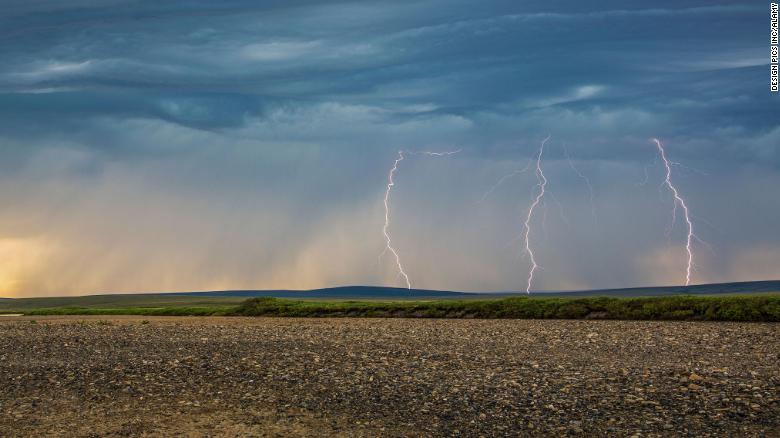Find out how many lightning strikes struck the US in 2021 0:54
(CNN) -
As extreme weather raged across the world in 2021, a staggering change occurred in the far north of the Arctic, largely out of sight but detectable by a network of sensors.
Lightning increased significantly in the region around the North Pole, which scientists say is a clear sign of how the climate crisis is altering global weather.
Vaisala, an environmental monitoring company that tracks lightning around the world, reported that 7,278 lightning strikes occurred north of 80 degrees latitude last year, nearly double the number in the previous nine years combined.
Lightning strikes in the Arctic are rare - and even more so so far north - and scientists use them as a key indicator of the climate crisis, as the phenomenon signals warming temperatures in this predominantly icy region.
Lightning occurs in energy storms associated with an unstable atmosphere, which requires relatively warm and humid air, which is why it occurs mainly in tropical latitudes and elsewhere during the summer months.
How the climate crisis is affecting tornadoes in the United States
The annual number of lightning strikes in the Arctic, the region north of about 65 degrees latitude, has remained constant for the past decade, but is now increasing significantly in the far north.
Chris Vagasky, a meteorologist and lightning applications manager at Vaisala, said global warming is loading the Arctic environment for more lightning strikes.
"What we have seen is that lightning and thunderstorms are developing over Siberia, and then moving over the Arctic Ocean and continuing far north," Vagasky told CNN, stressing that "the warm and humid air of all continents is now rising over the Arctic Ocean and persisting over the Arctic Ocean, so storms are developing there. "
José Martínez-Claros, a researcher at the Center for Western Climate and Water Extremes at the University of California, San Diego, who was not involved in the report, said the results were "worrying."
advertising
"It seems to suggest that now that climates are getting drier and warmer, these types of storms are reaching much higher latitudes than before and closer to the Arctic," he said.
A 2021 study also found that lightning in the Arctic had increased between 2010 and 2020 and that the trend was strongly linked to global warming, caused by fossil fuel emissions.
"We know that the Arctic climate is changing faster than the rest of the Earth," Vagasky said.
"And that's why monitoring these trends in thunderstorms and lightning in this very remote area helps us detect where these intrusions of warm and humid air occur in this region."
Lightning also increased in the United States during 2021, according to the Vaisala report, where more than 194 million lightning bolts occurred, 24 million more than recorded in 2020.
More than a million of them occurred in December, coinciding with several unprecedented severe winter weather outbreaks that ravaged the central and southern United States.
It was the largest number of lightning strikes researchers have recorded in December since 2015, Vagasky said, noting that now "even the December time period, it could be receiving spring or summer conditions," he added.
In the United States, Texas saw the most lightning strikes last year, primarily due to its large surface area and its warm, storm-prone location, Vaisala reports.
Florida was the state with the highest lightning density, with 223 lightning bolts per square mile, followed by Louisiana and Texas.
The researchers also found that wildfires caused by lightning burned more than 8,000 square kilometers in the United States last year.
In the drought-stricken west, dry lightning sparked deadly and destructive wildfires, like the one in Bootleg, Oregon, that burned more than 1,600 square kilometers.
British Columbia, which typically doesn't experience as much lightning as Canada's central provinces, also saw a particularly rare lightning outbreak when an unprecedented heat wave swept through the region.
Between June 30 and July 1, more than 700,000 were registered in the province.
Chilean beekeepers protest the drought and release bees in front of La Moneda;
there are cops with bites
Vaisala has been detecting lightning for almost 40 years in the United States and around the world since 2012. The network detects more than two billion lightning bolts around the world each year, according to Vaisala, including one from 2019 about 50 kilometers from the North Pole, which set a Guinness World Record for being the northernmost lightning bolt ever detected.
Vagasky said that as the climate crisis progresses and the Arctic continues to warm, changes in very remote regions will have a ripple effect on the entire planet's time.
"It's local all the time," Vagasky said.
"When these drastic changes occur, especially in places like the Arctic, these kinds of changes don't just affect the Arctic. The Earth is totally interconnected."
Climate change







